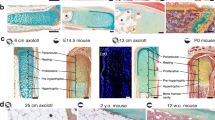Abstract.
The alterations that the epiphyseal plate undergoes during fracture healing are well documented microscopically, yet there are no reports in the literature which discuss the cellular and molecular changes that accompany this process. We studied fracture healing in 49 Wistar rats (5 weeks old) in which we inflicted a fracture to the distal third of the femur of the right hind leg (experimental side). The rats were killed 2 weeks later, and we dissected both hind legs from the hip joint to the knee joint, detaching all the surrounding soft tissues. We manually detached the distal epiphyses and the epiphyseal plates from both femurs. A piece of the epiphyseal plate was removed from the epiphyseal side of the femurs. In 25 animals, we analyzed the DNA content. In 8 animals, the specimen was studied under an electron microscope, and in the remaining 16 animals, the control and experimental sides were studied histologically. We found that healing was accompanied by an increase in DNA content, by a change in cellular activity, and by greatly accelerated apoptosis.
Similar content being viewed by others
Author information
Authors and Affiliations
Additional information
Received: December 7, 2000 / Accepted: August 22, 2001
About this article
Cite this article
Papavasiliou, A. Histological and biological changes in the epiphyseal plate during fracture healing. J Orthop Sci 7, 91–96 (2002). https://doi.org/10.1007/s776-002-8428-3
Issue Date:
DOI: https://doi.org/10.1007/s776-002-8428-3




